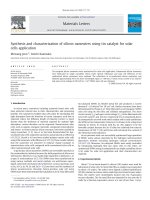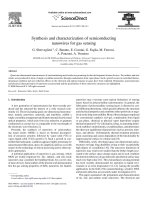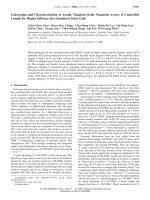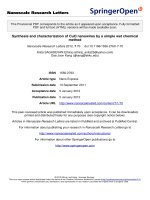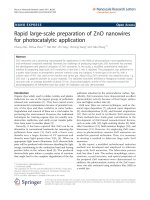Fabrication and characterization of semiconductor nanowires for thermoelectric application 3
Bạn đang xem bản rút gọn của tài liệu. Xem và tải ngay bản đầy đủ của tài liệu tại đây (11.99 MB, 24 trang )
Experimental Details 48
Chapter 3 Experimental Details
3.1
Four-point probe structure test device
!"#$%&'()'*+,&-./"+'+%011'1&+/"02'03'/,&'4560"2/'6%07&'/&1/'8&9"+&:'
The four-point (4-point) probe method is used to measure the electrical impedance of a
thin film or nanostructure. This method uses separate pairs of electrodes to carry the
current and to sense the resulting voltage drop. The advantage of the 4-point probe
measurement or Kelvin sensing is that the separation of the current and voltage
electrodes eliminates the resistance contribution of the connecting wires and contact
resistance to the measurement.
In a 4-point connection measurement, the current (I) is supplied through a pair of
connecting wires and electrodes (force connections). This will lead to a voltage drop
(V) across the impedance (resistance R) to be measured according to Ohm’s law, given
Experimental Details 49
as V = IR. However, the current will also generate a voltage drop across the connecting
wires/electrodes (force connections) that supply the current too since they carry certain
resistance. To prevent including that unwanted voltage drop in the measurement, an
extra pair of connections is made to measure the voltage as shown in Figure 21. Since
Rl is not included in the voltage measurement loop, the voltage drop across Rl will not
be measured. The voltmeter has almost infinite impedance (i.e., ideal voltmeter) so
there is negligible current flowing through Rv, which means a negligible voltage drop
across Rv. This will allow accurate measurement of the voltage difference across the
sample with resistance R. Therefore, the 4-point probe configuration is used in the
resistance measurement as well as the 3!! thermal conductivity measurement of the
nanowires in this project.
!"#$%&'()'*+,&-./"+'&0&+/%"+.0'1".#%.-'23'.'4562"7/'6%28&'-&.9$%&-&7/:'
Experimental Details 50
3.2 Sample preparation
Three types of Si substrate samples were used in this work for the Ge nanowire growth,
dispersing the Ge nanowires and depositing the contacting electrodes for thermal
conductivity measurement, and the investigation on the catalytic etching mechanism.
3.2.1 Si substrate for Ge nanowire growth
The Si substrate sample selected for Ge nanowire growth has the following
specifications:
Material: Silicon (Si)
Doping type: Boron – p type
Resistivity: 0.85-1.15 !"cm
Crystallographic orientation: (111)
Sample size: 6mm x 6mm
Wafer thickness 275um
Wafer diameter: 2 inches
After being diced, the Si substrates were cleaned by ultra-sonication in acetone and
then isopropyl alcohol (IPA) for 15 mintues each. The acetone is to remove organic
contaminants such as grease from the sample surface while IPA serves to eliminate
any possible contaminant residues that might be re-deposited onto the sample surface
when acetone was blown dry. The degreased Si wafers were then dipped in 2 wt%
hydrofluoric acid (HF) for 1 minute to remove the native oxide (SiOx) formed on its
surface. The Si substrates were then immediately transferred into a thermal evaporator
Experimental Details 51
(Edwards auto 306) containing high purity Au wire (99.99+% purity, Goodfellow) as
an evaporation source. A blanket Au deposition was then carried out onto the Si
substrate which was maintained at room temperature (see Figure 22). The base
pressure before the evaporation process was at the level of 10-7 mbar and the pressure
during evaporation was about 6 x 10-6 mbar. Proper out-gasing (of both the boat and
the source) prior to the Au evaporation onto the Si surface was carried out to minimize
incorporation of impurities into the evaporated Au film. The thickness of the
evaporated Au was typically 4-5 nm, as monitored in-situ by a quartz crystal
microbalance (QCM) and verified ex-situ by an atomic force microscopy (JEOL JSPM
5200).
!"#$%&'((')*+,-'."/#%/0'+1'23&'&4/5+%/2+%'6762&08'
The thin gold film agglomerated and was broken into individual dots (see Figure 23 (a))
by annealing the Au-coated Si substrates in vacuum (0.005 mbar) at 400oC for 30
minutes. The size of the Au-dots spreads over a large range of 5 to 90 nm with a mean
diameter of 50-60 nm.
Experimental Details 52
!"#$%&'()'*+,'-".%/#%012'/3'"45"6"5$07'8$95/:;'/<:0"4&5'<='044&07"4#'0'>'4-'8$'3"7-?'
3.2.2 Si substrate for dispersing Ge nanowire and depositing the
contacting electrodes
The Si substrate sample selected for dispersing the Ge nanowires and depositing the
contacting electrodes is similar to that used for the Ge nanowire growth except that it
has a thick layer of thermal oxide (1 !m) grown on it. A thick oxide is necessary for
isolation since the Ge nanowires are dispersed onto the Si substrate sample. Since
minimum transfer of heat from the Ge nanowire to the underlying substrate is needed
for the thermal conductivity measurement, a material of low thermal conductivity (k) is
needed as the substrate. The k of silicon oxide is 1.38 W/m/K as compared to bulk
germanium which has a k of 60.2 W/m/K. Thus, a Si substrate with thick oxide would
be suitable for the thermal conductivity measurement. The resistivity of the p type Si
under the oxide is 10 – 30 "#cm.
Similar to the substrate for Ge nanowire growth, the oxidized Si substrates were
Experimental Details 53
cleaned by ultra-sonication in acetone and then isopropyl-alcohol (IPA) for 15 mintues
each to remove organic contaminants and any possible contaminant residues that might
be re-deposited onto the sample surface when acetone was blown dry. However, the
oxidized Si substrate was not subjected for further HF treatment as the oxide had to be
preserved in this case. The degreased oxidized Si substrate was then ready for
dispersing of Ge nanowires which will be described in a later section.
3.2.3 Si substrate for investigation on the catalytic etching mechanism
The Si substrate sample selected for catalytic etching has the following specifications:
Material: Silicon (Si)
Doping type: Boron – p type
Resistivity: 4-8 !"cm
Crystallographic orientation: (100)
Sample size: 6mm x 6mm
Wafer thickness: 275um
Wafer diameter: 2 inches
Silicon with (100) orientation is chosen since catalytic etching is well-known to occur
anisotropically along the (100) directions. Etching in inclined directions on non-(100)
substrates will complicate the investigation. The preparation steps for the Si (100)
substrates is similar to the substrates used for Ge nanowire growth. After cleaning, the
substrates will be put into the evaporator for deposition of various metals before
Experimental Details 54
immersing them in the hydrofluoric acid/hydrogen peroxide (HF/H2O2) solution for
chemical etching.
3.3 Ge nanowire growth
The process chosen for Ge nanowire growth is VLS as discussed in section 2.3.1.1.
Growth of GeNWs was carried out in a three-zone furnace (Lindberg/Blue
STF55346C). A small amount (about 200 mg) of high purity Ge powder (99.999+%
purity, Sigma-Aldrich) was loaded at the close-end of a small quartz tube while the
Au-dotted Si substrates were placed near to the open-end of the tube as indicated in
Figure 24(a). Before the wire growth, the chamber was pumped down to a base
pressure of 0.01 mbar to minimize the presence of unintended contaminating gases
such as H2O and O2. A counter-flow of Argon (Ar) gas, at a flow rate of 150 sccm,
was then introduced during the wire growth. The pressure during growth was
constantly maintained at 2.66 mbar by an automatic metallic-throttle valve (MKS Type
253B) with PID feedback control.
The temperature profiles used for various sections of the furnace are shown in Figure
24(b). Ge powders and the Au-dotted Si substrates were heated from room temperature
to 900!C in 60 minutes at a uniform ramp up rate. The temperature of the Ge source
and the substrates were then maintained at 900!C for another 60 minutes before the
system was allowed to cool down to room temperature. At 900!C, Ge vapour would be
produced from the Ge powder. The Ge vapour would then be transported to and
condensed onto the Au-dotted Si substrates, contributing to Ge nanowire (GeNW)
growth in the VLS process. A counter-flow of Ar in this case serves to increase the
Experimental Details 55
residence time of the Ge vapour over the substrate, allowing the formation of
high-density Ge nanowires.
!"#$%&'()'*+,'-&.$/'01%'2&34'#%15.67'+89'*:,'.&;/&%+.$%&'/%10"<&='01%'2&34'#%15.6>'
3.4 Scanning electron microscope examination
The scanning electron microscope (SEM) is a type of microscope that uses a beam of
high energy electrons to image a sample by scanning it in a raster scan manner. The
interaction of the electrons with the atoms of the sample produces signals and
information of the sample surface such as composition, topography and electrical
conductivity. A SEM has the capability to image a sample with magnification from 10
times to more than 500,000 times.
The SEM used for this work is the Philips Nova Nanosem 230. This SEM was used in
Experimental Details 56
many occasions to check the micro-sized or nano-sized sample to ensure this has the
desired structures before proceeding to the next step of experiment. For the Ge
nanowire growth, the SEM was important for checking the structure of the Ge
nanowires produced since a slight change in the growth temperature or duration could
potentially cause very different morphology of the nanowires fabricated. Figure 25
shows a SEM image of typical Ge nanowires grown in the three-zone furnace as
mentioned in section 3.3. A charging phenomenon was observed when certain spots or
certain nanowires were viewed under SEM for a long time. This is due to the dielectric
nature of the native oxide on the silicon substrate and germanium nanowire samples.
One possible way that SEM can affect the sample is through carbon contamination.
Although the SEM chamber was pumped down to an extremely low pressure level,
traces of residual gas such as hydrocarbons can still be found in the SEM chamber.
The energy from the electron beam could cause the hydrocarbons to be deposited on
the spot of the sample being viewed. The contamination will be worse when the beam
energy is high with high magnification viewing. To eliminate the possibility of carbon
contamination, the nanowires of the sample viewed under SEM will not be used for the
subsequent experiment. Only the neighbouring die from the same batch of nanowires
will be used for the next step of dispersing the nanowires onto the oxidized substrate.
Typical electron beam energy to view nano-sized features is between 10 to 20 keV and
the sample has to be placed at a distance of about 5 mm from the final lens of the SEM
for best focus.
Experimental Details 57
!"#$%&'()'*+,'"-.#&'/0'123"4.5'6&'7.7/8"%&9'#%/87':2'1;&'<=*'3%/4&99>'
3.5 Nanowire integration
After SEM examination to ensure that the Ge nanowires grown from the three-zone
furnace are of the desirable length, diameter and uniformity, a neighbouring Si sample
with Ge nanowires that has not been viewed under SEM before was transferred to a
small 30 ml glass bottle. Since the Ge nanowires are very fragile, care had to be taken
to ensure the side of the Si die with the grown Ge nanowires did not face downwards
and come into contact with the bottom of the bottle throughout the transfer. 5 drops of
MOS-grade ethanol were transferred into the bottle by a micro-pipette. The bottle, with
the nanowires sample soaked in ethanol, was then subjected to sonication for 10
seconds to disperse the Ge nanowires in the ethanol solution. The bottle was placed in
a water bath during the sonication process to reduce the power of the vibration that the
nanowires were exposed to. Otherwise, the nanowires can further break into shorter
segments which will make the subsequent electrode deposition for contact formation
Experimental Details 58
difficult. Since the nanowires can easily clump together in the solution, the bottle of
nanowires solution had to be put through sonication for another 5 seconds if the bottle
of solution was left to stand for more than 60 seconds. After the nanowires were
dispersed into the ethanol solution in the bottle, the nanowires solution was extracted
by a micro-pipette. Since only a very small amount of nanowires solution was needed,
merely dipping the micro-pipette into the solution would be able to draw enough
nanowires solution up the micro-pipette by capillary force. With the pipette tip in
contact with a cleaned oxidized Si substrate, the Van der Waals forces will pull the
nanowires solution out from the pipette to coat the oxidized Si substrate evenly. The
oxidized substrate with dispersed nanowires was immediately put into an oven at
120!C for 10 seconds to ensure that the solvent evaporates quickly so that the
nanowires would not have time to move and join to form clumps.
After the substrate with dispersed Ge nanowires was cooled to room temperature,
poly(methyl methacrylate) or PMMA will be spin-coated onto the substrate using the
Cookson Spincoater P6700 at about 2000 revolutions per minute (rpm). PMMA was
used as a type of organic resist for the electron beam lithography process described
later in section 3.7. After the substrates were spin-coated with PMMA, the substrates
were put into the oven at 120 !C for 15 minutes to drive out excess moisture in the
PMMA.
3.6 Optical microscope examination
Optical microscopy is a convenient and non-destructive method to obtain an image of
a small feature with dimensions larger than a quarter micron. The optical microscope
Experimental Details 59
used in this work is the Leica DMLM microscope. The microscope is able to give
magnification from 50x to 1000x.
After the Ge nanowires samples were cooled to room temperature, optical microscope
examination was used to search for single straight nanowires. The selected nanowires
had to be long enough (25 µm or longer) for the 4 electrode contacts to be deposited
across and clear of other nanowires which could otherwise short the 4 electrodes. After
that, measurements of the selected nanowire location relative to the markers on the
substrate will be made and recorded as shown in Figure 26. The markers were
pre-fabricated to help in locating a nanowire on a large area substrate. With markers
and information on the relative coordinates of the nanowires available, it was possible
to move the electron beam (e-beam) to the desired location for subsequent e-beam
lithography without exposing the surrounding area.
!"#$%&'()'*&+,$%&-&./,'01'/2&'304+/"0.'01'/2&',&3&4/&5'6&'.+.07"%&'7&%&'%&40%5&5'".'8'+.5'
9'400%5".+/&,'7"/2'/2&'4&./&%'01'/2&'-+%:&%'+,'/2&'0%"#".;'
Experimental Details 60
The markers were pre-fabricated on the oxidized Si substrate by the optical lithography
process. Positive photoresist AZ5412 was first spin-coated onto the oxidized Si
substrate using the Cookson Spincoater P6700 at about 6000 rpm for 45 seconds. The
photoresist was then baked at 90!C for 30 minutes to remove excess moisture. After
the substrates had cooled down to room temperature, the photoresist was put in direct
contact with the chrome mask and exposed for 1 minute 50 seconds. The substrates
were subsequently developed in AZ1512 for 1 minute 5 seconds. After the standard
thermal evaporation of Cr (10 nm) followed by Au (40 nm) in the thermal evaporator
(Edwards auto 306), the substrates were soaked in acetone for more than 60 minutes
during the liftoff process. The substrates with markers were cleaned in acetone and
IPA as mentioned in chapter 3.2.2 before Ge nanowires were dispersed on them.
3.7 Electron beam lithography
With the coordinates of the two ends of the Ge nanowires, the e-beam system, the
Elphy Quantum Plus Advanced SEM/FIB system, was setup for the e-beam
lithography process. This e-beam system was capable of fabricating feature sizes of
larger than 300 nm on PMMA. The coordinates of the Ge nanowires were first keyed
into the system so that the software program knows where the selected nanowires are
located. Then the desired pattern, or 4 electrodes with bond pads in this case, were
drawn by the software with the drawing tools given. Once the settings were determined,
a dummy sample without nanowires was put into the chamber of the Phillips XL30
FEG SEM for the e-beam lithography process. A dummy sample was used here for
calibration purpose to find out the right dose, resolution and developing time.
Over-exposure will increase the total process time while under-exposure will lead to
Experimental Details 61
PMMA remaining in the exposed area. After electrode metal deposition, part of the
metal on the features would be washed off during liftoff. If the metal on the feature
area is connected with the surrounding metal on PMMA, there will be problems for
successful liftoff. If the PMMA is over-developed, the edge of the feature would be
sloped and there is a high chance of the metal at the feature area connecting with the
surrounding metal on the PMMA. If the PMMA is under-developed, PMMA will
remain on part of the features. These will again cause problems in liftoff after the
electrode deposition.
A typical e-beam lithography process was started by placing samples onto a special
stage in the chamber of the Phillips XL30 FEG SEM. A beam energy of 30 keV was
required for the e-beam lithography process. After pumping down, the e-beam spot
was moved to a part of the substrate far away from the wanted feature. Here, the focus,
stigmatism, beam shift and lens modulation were adjusted for best resolution and
clarity on the SEM. The e-beam was then moved to a feature of the stage that allowed
the e-beam current to be measured by the e-beam lithography system so that the
residual time for the e-beam during exposure can be calculated. The e-beam must be
deflected or shut off when the beam was moving from point to point as there was
always a chance of unintentional exposure of any part of the PMMA when the beam
was left on while moving. After current measurement, the e-beam was moved to a
marker at the edge of the sample that was not used. With the beam off, the e-beam was
moved to the marker (the origin) where the coordinates of the nanowires were taken.
After a final slight touch up on the focus, the control can be handed over to the e-beam
lithography system from the SEM system.
Experimental Details 62
Since features like the nanowire can be very small, the accuracy on the position is of
paramount importance. At least 3 neighbouring markers were scanned in the Elphy
Quantum Plus e-beam system to make sure that the origin of the feature pattern drawn
earlier on matched with the actual origin that the e-beam was at. Adjustments had to be
made if the virtual markers did not coincide with the actual markers seen on the screen.
After everything was set, the e-beam lithography process can begin. A typical pattern
with 4 square bond pads of 250 µm width and electrodes will take about 1 hour 10
minutes for the exposure to complete.
The exposed substrates were developed in a solution of the PMMA developer, Methyl
isobutyl ketone (MIBK) and IPA in a ratio of 1:1, for 75 seconds. Figure 27 shows the
pattern of the 4 electrodes drawn after the e-beam lithography process and PMMA
development. It can be clearly seen that the Ge nanowire remained nicely across all 4
electrodes. Also, there were no signs of residual PMMA left in the electrode area.
Since the entire pattern of electrodes with bond pads took up 1000 µm x 1000 µm of
space, nanowires found at 500 µm from the edge of the substrate cannot be used or
part of the pattern will not be drawn. Also, the PMMA near the edge of the substrate
tend to be less uniform in thickness. This introduced variations in the exposure process
and may lead to under-exposure problem.
Experimental Details 63
!"#$%&' ()' *+,,&%-' ./' ,0&' 1' &2&3,%.4&5' 4%+6-' +/,&%' &78&+9' &:;.5$%&' +-4' *<<='
4&>&2.;9&-,?'
3.8 Electrode deposition
With the bond pads and electrodes drawn, the samples were placed into the chamber of
the thermal evaporator (Edwards auto 306) for electrode deposition. Gold wires
containing high purity Au (99.99+% purity, from Good Fellow) and chromium wire
(99.9% purity) were used as the evaporation sources. A blanket deposition of Cr (10
nm) was first evaporated at one side of the chamber. The sample holder was then
rotated such that the samples would be directly above the Au source. A blanket
deposition of Au (100 nm) was then evaporated onto the samples at the other side of
the chamber. The base pressure before the evaporation process was at the level of 10-7
mbar and the pressure during evaporation was about 6 x 10-6 mbar. Although PMMA
Experimental Details 64
was more robust than the photoresist AZ5412, the evaporation had to be performed in
steps to ensure that the PMMA film did not change when the temperature was too high.
Preferably, 10 minutes of break was needed for every 15 minutes of evaporation.
After the evaporation was performed and substrates were cooled to room temperature,
the samples were soaked in acetone for 2 hours. The liftoff process was performed by
gently swirling the beaker of samples in acetone until the surrounding unwanted metal
film was washed off. Figure 28 shows an image of the nanowire sample with 4
electrodes laid across it.
!"#$%&'()'*+,#&'-.'/0&'1'&2&3/%-4&5'6"/0'7&'8,8-6"%&',3%-55',./&%'/0&'2"./-..'9%-3&55:'
To reduce the contact resistance between the Ge nanowire and the Cr/Au electrodes,
the sample was annealed at 475!C for 10 minutes to activate the chemical reaction that
Experimental Details 65
transforms GeO2 to GeO; the latter will then be desorbed [91]. For complete
desorption of GeO, the temperature was raised to 500 !C for another 10 minutes.
3.9 Probe station and parameter analyzer characterization
The probe station was used to check the I-V characteristic of the Ge nanowire sample
and to find out the electrical resistance of the sample. The probe station used is a
typical black chamber equipped mainly with adjustable manipulator probe tips
connected to an external parameter analyzer. Other accessories include an optical
microscope for the correct positioning of the probes onto the sample and a light source
with adjustable power.
The parameter analyzer that was used is the model HP 4155B. It is composed of
several Source/Measurement Units (SMUs). From the point of view of the parameter
analyzer, the probe tip connected to an SMU can serve as a source, or as a source and a
measurement unit. The SMU can be used as a voltage or a current source. The analyzer
allows several modes of operation, mainly the sampling mode and the sweep mode. In
sampling mode, the source value is constant and other SMU values are recorded versus
time at the desired frequency. In sweeping mode, the source value can be swept,
meaning incrementally increased or decreased at a chosen frequency, and other SMU
values are recorded at each step of the sweep.
For testing of the Ge nanowire sample, voltage source biasing was selected. A
manipulator probe in the probe station connected to SMU 1 was used to probe the gold
bond pads on the sample that were connected by the electrodes and the Ge nanowire.
The circuit was closed either by connecting the stage chuck to the parameter analyzer
Experimental Details 66
and setting to ground or probing SMU 3 to the other bond pad that was connected to
SMU 1 through the Ge nanowire. SMU 3 was set to sweep from 0 to 2 volts in 500
steps of 4 millivolts while SMU 1 was set at a constant zero volts.
3.10 Thermal conductivity measurement
After testing the electrical resistivity of the Ge nanowire and the contact resistance, the
sample was put into an in-house constructed vacuum chamber for the thermal
conductivity measurement. The 3! method described in section 2.5.1 of Chapter 2 was
used for the measurement. Figure 29 shows the in-house constructed vacuum chamber
where the sample was put in for the thermal conductivity measurement. The chamber
was connected to an Edwards E2M5 Dual Stage Rotary Vane Vacuum Pump that was
capable to lower the pressure in the chamber to 10-3 mbar. There were 8 feed-throughs
in the chamber. Two of these were connected to the Keithley 6221 AC and DC current
source that provided the a.c. current bias through the Ge nanowire. Another two
feed-throughs were connected to the Standford SR850 lock-in amplifier that extracted
the third harmonic voltage. The feed-throughs on the right side of the chamber were
connected to a thermocouple and a Watlow Ceramic Heater for measurement at high
temperature. Both the thermocouple and the ceramic heater were connected to the
EZ-Zone Express PID Controller and Control Box.
Experimental Details 67
!"#$%&'()'*+&'",-+.$/&'0.,/1%$01&2'340$$5'0+456&%'$/&2'7.%'1+&'8!-5&1+.2'1+&%549'
0.,2$01"3"1:'5&4/$%&5&,1;'
Working Range of Current and Frequency
As explained in section 2.5.1 in Chapter 2, there are two conditions that must be met
for our assumptions to be true. Firstly, we have Eq. (2.5) (repeated here as Eq. (3.1))
which must be satisfied for heating power inhomogeneity caused by resistance
fluctuation along the specimen to be much less than the total heat power. Given the
dimensions of the specimen, this condition limits the amplitude of the a.c. current,
length and diameter of specimen as follows:
(3.1)
Experimental Details 68
Another assumption is that radiation heat loss can be neglected if Eq. (3.1) is satisfied.
Equation (2.10) (repeated here as Eq. (3.2)) limits the temperature of the experimental
environment, length and diameter of the specimen as follows:
(3.2)
where g = 16!"T0 3/(#CpD),
$ = L2/(%2&)
and
& = k/(#Cp).
Equation (3.3) should be satisfied for the thermal conductivity calculated to be within
+/-3.5% of the actual value.
0 < 2'$ < 4
(3.3)
The parameters of the lock-in amplifier have to be carefully chosen in order to obtain
stable signals with minimum noise. In this current study, 1 mV full scale with
maximum dynamic reserve was set in the instrument. Since the working frequency for
the Ge nanowire sample was 1000 Hz, 0.03 s of time constant was sufficient for
stability.
3.11 Ceramic heater setup for temperature dependence
characterization of thermal conductivity
The feed-throughs on the right end of the in-house constructed vacuum chamber
(Figure 29) for thermal conductivity measurement were connected to a thermocouple
that was embedded in the Watlow Ceramic Heater (Figure 30) for measurement at high
Experimental Details 69
temperature. Both the thermocouple and the ceramic heater were connected to the
EZ-Zone Express PID Controller and Control Box.
!"#$%&' ()' *+,-./' 0&%+1"0' 2&+,&%' ,.' 2&+,' $3' ,2&' /2.-&' 0&%4"3' 3+05+#&' /",2' ,2&' 6&'
7+7./"%&'8+13-&9'
The Watlow Ultramic Ceramic heater is capable of operating up to 400!C (752!F) with
a fast temperature ramp rate of up to 150!C per second. However, to ensure that the
sample did not suffer from non-uniform expansion resulted from fast heating, the ramp
rate was controlled at 5!C per second. The heater is able to provide a power output of
155W/cm2 (1000W/inch2).
3.12 X-ray photoelectron spectroscopy (XPS)
Metal-assisted catalytic etching was used to fabricate Si nanowires used for the
thermal conductivity measurement. Since some aspects of the catalytic etching
Experimental Details 70
mechanism was still unclear (e.g., whether Si was a diffusing species), the mechanism
was also investigated in this work. X-ray photoelectron spectroscopy (XPS) was used
to check if there was diffusion of the Si species through the catalyst metal layer during
the etching process.
XPS is one of the common technique to measure the elemental composition, empirical
formula, chemical state and electronic state of the elements that exist within a material.
When a beam of X-rays is shone on a material, the kinetic energy and number of
electrons that escape from the top 1 to 10nm of the material is being analysed. With
the information, XPS spectra can be obtained. Ultra high vacuum of 10-9 mbar is
required for this technique.
3.13 Auger electron spectroscopy (AES)
Other than XPS, Auger electron spectroscopy (AES) was also used to confirm whether
Si atoms had diffused through the layer of metal catalyst during the catalytic etching
process.
AES is a common analytical technique used specifically in the study of surfaces and
more generally in the area of materials science. The Auger effect refers to the
inter-state and intra-state transition process of electrons in an excited atom. When an
atom is excited by an external source, such as by a photon or electron beam in the
range of 2 keV to 5 keV, a core state electron can be kicked out, leaving behind a
vacancy. In this unstable state, an electron from the outer shell will move in to fill up
the vacancy at the lower energy level. This leads to the emission of an amount of
energy equal to the difference in the orbital energies. The transition energy can be
Experimental Details 71
coupled to a second outer shell electron, which will be emitted as an Auger electron
from the atom, if the transferred energy is greater than the orbital binding energy.
AES is especially surface sensitive because the emitted Auger electrons usually have
energies from 50 eV to 3 keV. Electrons at such energy levels have short mean free
paths in a solid. Thus, the escape depth of the electrons is limited to within a few
nanometers of the target surface. This extremely high sensitivity to surface species is
very important since the thickness of the metal catalyst deposited is only about 30 nm.
Although AES and XPS give similar information on chemical composition, AES has
advantage over XPS because of its spot size that is much smaller than that of XPS.
Thus, AES is better in spatial analysis and identifying fine features. On the other hand,
XPS has the capability of determining surface chemical structure and bonding through
the use of chemical shifts. Although Auger lines also exhibit chemical shifts, these are
not generally as large or as well-documented as those obtained by XPS.
Note: XPS is also a surface sensitive technique, just like AES, but can give
composition information (unlike AES). I thought why XPS was not successful in
confirming if diffusion of Si atoms occur is because the probe beam is a large area
beam (poor spatial resolution) and thus it will cover regions of the metal film with
cracks as well as those without cracks. We do not know if the detected Si species is
due to the movement of the Si atoms through the cracks. Anyway, I think you should
also mention about the XPS results in Chapter 5 before you show the AES results.


